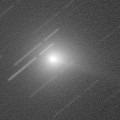
|
Now it is so bright as 6.8 mag (May 6, Chris Wyatt). In the Southern Hemisphere, it keeps observable in good condition until late June. In the Northern Hemisphere, it keeps unobservable until September when the comet will be fainter than 13 mag. It must have been observable at 16 mag in good condition in 2014 autumn, but it was not discovered.
Date(TT) R.A. (2000) Decl. Delta r Elong. m1 Best Time(A, h)
May 9 1 44.88 -34 48.5 0.502 0.831 55 6.2 3:26 (293,-32)
May 16 4 33.00 -29 5.0 0.489 0.794 50 5.9 20:35 ( 76,-33)
|

|
It brightened up to 3.7 mag and became a naked eye comet in mid January (Jan. 13, Marek Biely). Now it is fading. But it is bright as 7.5 mag still now (May 8, Neil Norman). In the Northern Hemisphere, it keeps observable all night until July when the comet will fade down to 13 mag. It is not observable in the Southern Hemisphere.
Date(TT) R.A. (2000) Decl. Delta r Elong. m1 Best Time(A, h)
May 9 1 27.51 80 19.0 2.145 1.929 64 8.5 3:26 (191, 32)
May 16 1 21.76 83 22.7 2.196 2.000 65 8.9 3:17 (188, 34)
|
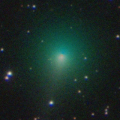
|
Now it is bright as 9.8 mag (May 6, Chris Wyatt). In the Southern Hemisphere, it keeps observable in good condition for a long time until the comet fades out. In the Northern Hemisphere, it keeps extremely low and hard to observe until June. It will be observable in good condition after June while the comet will be fading gradually.
Date(TT) R.A. (2000) Decl. Delta r Elong. m1 Best Time(A, h)
May 9 23 41.29 -5 51.9 1.725 1.406 54 8.8 3:26 (282, 7)
May 16 0 0.71 -3 52.8 1.719 1.427 56 8.9 3:17 (280, 8)
|
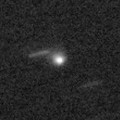
|
Now it is 12.5 mag (Apr. 30, Michael Mattiazzo). It will approach to the sun down to 0.3 a.u. in July, and it is expected to brighten up to 3 mag. In the Southern Hemisphere, it is observable in the extremely low sky until early June. Then it becomes unobservable temporarily, but it will be observable after mid July, and keeps observable while the comet will be fading gradually. It will not be observable after this in the Northern Hemisphere.
Date(TT) R.A. (2000) Decl. Delta r Elong. m1 Best Time(A, h)
May 9 1 28.87 7 39.7 2.265 1.410 24 10.8 3:26 (255, -7)
May 16 1 46.61 10 44.9 2.111 1.282 26 10.2 3:17 (253, -5)
|
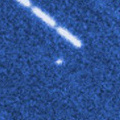
|
It brightened up to 12.8 mag until March (Mar. 21, Michael Mattiazzo). It will brighten up to 10.5 mag in May and June, but it is not observable. In the Northern Hemisphere, it will be observable after autumn while the comet will be fading.
Date(TT) R.A. (2000) Decl. Delta r Elong. m1 Best Time(A, h)
May 9 3 26.69 12 10.5 2.362 1.369 7 10.8 20:27 (119,-17)
May 16 3 47.85 15 0.7 2.359 1.357 5 10.7 20:35 (124,-18)
|
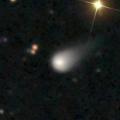
|
Now it is 11.9 mag (May 6, Chris Wyatt). It is expected to brighten up to 4 mag from autumn to winter. But it is fainter than this ephemeris recently. It keeps observable in excellent condition until autumn in the Southern Hemisphere. In the Northern Hemisphere, it is hardly observable until December.
Date(TT) R.A. (2000) Decl. Delta r Elong. m1 Best Time(A, h)
May 9 23 38.43 -22 46.7 3.344 3.035 63 10.9 3:26 (296, -3)
May 16 23 42.70 -23 26.2 3.148 2.951 69 10.7 3:17 (298, -1)
|
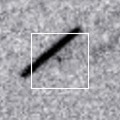
|
It will brighten up to 11 mag in April and May. But the condition is bad in this apparition. In the Southern Hemisphere, it is getting higher gradually in the morning sky. It will not be observable until late July in the Northern Hemisphere.
Date(TT) R.A. (2000) Decl. Delta r Elong. m1 Best Time(A, h)
May 9 1 31.99 -0 13.3 2.377 1.561 28 11.5 3:26 (261,-13)
May 16 1 51.19 0 49.0 2.392 1.599 30 11.6 3:17 (260,-12)
|
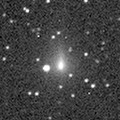
|
It brightened up to 9.5 mag from March to April (Apr. 7, Juan Jose Gonzalez). Now it is fading and getting diffuse rapidly. It has already faded down to 12.5 mag (May 7, Danil Sidorko). It seems to be a fragment of Comets C/1988 A1 (Liller) and C/1996 Q1 (Tabur). It will be fading after this, but it is observable in excellent condition in the Northern Hemisphere. In the Southern Hemisphere, it is not observable until June.
Date(TT) R.A. (2000) Decl. Delta r Elong. m1 Best Time(A, h)
May 9 11 3.95 74 12.9 1.084 1.364 81 12.0 20:27 (177, 51)
May 16 11 25.37 63 55.6 1.142 1.456 84 12.4 20:35 (170, 61)
|
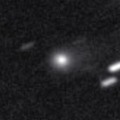
|
Now it is 14.9 mag (Apr. 1, Taras Prystavski). In 2015, it keeps 13-14 mag and will be observable in good condition for a long time.
Date(TT) R.A. (2000) Decl. Delta r Elong. m1 Best Time(A, h)
May 9 19 24.43 -9 13.6 2.909 3.470 115 13.2 3:26 (341, 44)
May 16 19 26.59 -8 55.5 2.836 3.476 121 13.2 3:17 (347, 45)
|
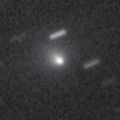
|
Now it is 13.0 mag and visible visually (May 7, J.P.Navarro Pina). It will brighten up to 11 mag in 2015 autumn. In this apparition, it is observable until the highlight while the comet is brightening.
Date(TT) R.A. (2000) Decl. Delta r Elong. m1 Best Time(A, h)
May 9 12 24.82 5 27.0 1.404 2.236 135 13.4 21:17 ( 0, 60)
May 16 12 22.15 5 31.1 1.423 2.194 127 13.2 20:47 ( 0, 60)
|

|
Outburst occured on May 6. Now it is bright as 11.8 mag (May 8, Chris Wyatt).
Date(TT) R.A. (2000) Decl. Delta r Elong. m1 Best Time(A, h)
May 9 17 54.34 -31 43.9 5.254 6.045 138 13.5 2:50 ( 0, 23)
May 16 17 52.00 -31 46.7 5.184 6.043 145 13.4 2:20 ( 0, 23)
|
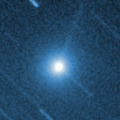
|
It brightened up to 8.2 mag in April (Apr. 8, Juan Jose Gonzalez). Now it is fading. It has already faded down to 12.0 mag (May 7, J.P.Navarro Pina). In the Northern Hemisphere, it keeps locating high in the evening sky in May, but it will fade out rapidly after this. It is not observable in the Southern Hemisphere.
Date(TT) R.A. (2000) Decl. Delta r Elong. m1 Best Time(A, h)
May 9 7 1.17 44 28.3 1.215 1.072 56 13.7 20:27 (122, 39)
May 16 7 27.47 41 11.7 1.452 1.202 54 14.6 20:35 (119, 36)
|
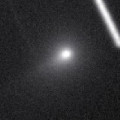
|
It brightened up to 9.2 mag in March (Mar. 9, Juan Jose Gonzalez). Now it is fading, but it is bright as 11.0 mag still now (May 1, Seiichi Yoshida). In the Northern Hemisphere, it will be getting higher gradually after this. It is not observable after this in the Southern Hemisphere.
Date(TT) R.A. (2000) Decl. Delta r Elong. m1 Best Time(A, h)
May 9 1 42.80 51 40.3 2.071 1.417 37 14.2 3:26 (218, 17)
May 16 1 48.61 56 20.1 2.112 1.518 41 14.7 3:17 (215, 21)
|
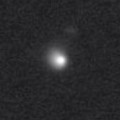
|
It brightened very rapidly. Now it is so bright as 14.6 mag and visible visually (Apr. 12, Sandor Szabo). It keeps 14-15 mag for a while after this. In the Northern Hemisphere, it will be getting lower gradually after May, and will be unobservable in mid June. In the Southern Hemisphere, it will be getting lower gradually after June, and will be unobservable in early August.
Date(TT) R.A. (2000) Decl. Delta r Elong. m1 Best Time(A, h)
May 9 9 3.61 8 25.0 3.324 3.440 88 14.3 20:27 ( 61, 46)
May 16 9 9.15 7 58.6 3.413 3.435 82 14.3 20:35 ( 68, 41)
|
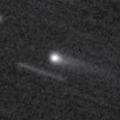
|
Now it is 15.5 mag (Apr. 15, J. Oey, P. Camilleri, H. Williams). It is expected to brighten up to 12 mag from July to August. In the Southern Hemisphere, it keeps observable in good condition until summer. In the Northern Hemisphere, it will be getting higher gradually after May, and will be observable in good condition after summer.
Date(TT) R.A. (2000) Decl. Delta r Elong. m1 Best Time(A, h)
May 9 20 44.35 -35 5.5 1.569 2.050 103 14.6 3:26 (332, 13)
May 16 20 50.08 -32 32.1 1.440 1.999 108 14.3 3:17 (334, 17)
|

|
It brightened up to 6.9 mag in 2014 autumn (Oct. 17, Marco Goiato). Now it is fading. But it is bright as 12.6 mag still now (Feb. 9, Chris Wyatt). In the Southern Hemisphere, it had been unobservable temporarily for a while, but it will be observable in good condition again after this. It will be observable again in mid June also in the Northern Hemisphere.
Date(TT) R.A. (2000) Decl. Delta r Elong. m1 Best Time(A, h)
May 9 0 51.69 -16 39.7 4.271 3.651 46 14.6 3:26 (281,-14)
May 16 0 53.40 -16 41.1 4.258 3.726 52 14.7 3:17 (283,-10)
|
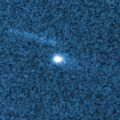
|
Now it is 16.4 mag (Apr. 22, Jean-Francois Soulier). It will brighten up to 11 mag from August to October. In the Northern Hemisphere, it will be getting higher gradually after July, then it keeps observable in good condition. In the Southern Hemisphere, it keeps low until November.
Date(TT) R.A. (2000) Decl. Delta r Elong. m1 Best Time(A, h)
May 9 0 53.85 1 15.2 2.401 1.681 35 15.0 3:26 (266, -4)
May 16 1 12.62 3 22.6 2.324 1.630 36 14.7 3:17 (264, -3)
|
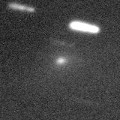
|
Now it is 15.3 mag (Mar. 28, Taras Prystavski). Distant object, but it keeps observable at 14-15 mag for a long time from 2015 to 2016.
Date(TT) R.A. (2000) Decl. Delta r Elong. m1 Best Time(A, h)
May 9 21 22.98 -1 48.9 5.595 5.606 85 15.2 3:26 (303, 35)
May 16 21 25.66 -1 30.2 5.467 5.582 91 15.2 3:17 (307, 38)
|
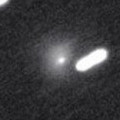
|
Very far object. However, outburst occured on Feb. 20, and it brightened up to 15 mag. It is bright as 15.8 mag still now (Mar. 28, Ken-ichi Kadota). It is reported so bright visually as 12.5 mag (Mar. 22, Marco Goiato). It locates high in the Southern Hemisphere. But it locates somewhat low in the Northern Hemisphere.
Date(TT) R.A. (2000) Decl. Delta r Elong. m1 Best Time(A, h)
May 9 12 1.96 -21 16.0 8.371 9.141 137 15.2 20:54 ( 0, 34)
May 16 12 1.25 -20 55.7 8.440 9.140 131 15.2 20:35 ( 3, 34)
|
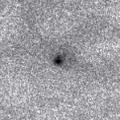
|
It must have brightened up to 11 mag from January to February, but no observations have been reported. Now it is 16.7 mag (Apr. 27, Hidetaka Sato). In the Southern Hemisphere, it is observable in the morning sky after this while the comet will be fading. In the Northern Hemisphere, it will be getting higher after July, but the comet will be faitner than 17 mag.
Date(TT) R.A. (2000) Decl. Delta r Elong. m1 Best Time(A, h)
May 9 0 34.65 -12 51.3 2.211 1.694 47 15.3 3:26 (280, -8)
May 16 0 50.74 -12 2.3 2.218 1.745 49 15.5 3:17 (280, -7)
|

|
Now it is 17.1 mag (Apr. 27, Hidetaka Sato). First return of a comet re-discovered after 112-year blank in 2008. It brightened up to 12 mag in 2008. In this apparition, it was expected to brighten up to 15 mag from spring to summer, but it is fainter than predicted. It keeps locating low in the morning sky for a while.
Date(TT) R.A. (2000) Decl. Delta r Elong. m1 Best Time(A, h)
May 9 23 53.02 5 19.7 2.026 1.538 47 15.3 3:26 (271, 11)
May 16 0 13.37 6 43.2 1.996 1.537 49 15.3 3:17 (270, 11)
|
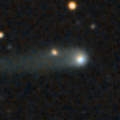
|
Now it is 15.3 mag (Jan. 7, Taras Prystavski). It keeps 15 mag for a long time from 2014 to 2015. It is observable in excellent condition in 2014 in the Southern Hemisphere, or in 2015 in the Northern Hemisphere. It becomes unobservable temporarily from March to May.
Date(TT) R.A. (2000) Decl. Delta r Elong. m1 Best Time(A, h)
May 9 1 36.29 12 58.2 4.839 3.914 21 15.3 3:26 (250, -6)
May 16 1 41.77 14 28.6 4.805 3.922 26 15.3 3:17 (251, -2)
|

|
Now it is 15.8 mag (Feb. 22, Taras Prystavski). It will brighten up to 14 mag from 2015 to 2016. In the Southern Hemisphere, it becomes unobservable temporarily from April to May, but it will be observable in good condition again after June. It will be observable in good condition after July also in the Northern Hemisphere.
Date(TT) R.A. (2000) Decl. Delta r Elong. m1 Best Time(A, h)
May 9 3 0.77 1 0.4 5.260 4.300 16 15.4 3:26 (245,-29)
May 16 3 3.03 1 54.7 5.235 4.286 18 15.4 3:17 (248,-25)
|
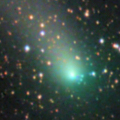
|
It brightened up to 9 mag from autumn to winter in 2014. Now it is fading rapidly. It has already faded down to 14.2 mag (Apr. 11, Yasukazu Ikari). In the Northern Hemisphere, it will be observable in excellent condition after this while the comet will be fading. In the Southern Hemisphere, it is hardly observable after this.
Date(TT) R.A. (2000) Decl. Delta r Elong. m1 Best Time(A, h)
May 9 14 40.01 56 58.7 2.507 2.946 105 15.4 23:29 (180, 68)
May 16 14 12.30 56 37.7 2.629 3.017 102 15.7 22:34 (180, 68)
|

|
It brightened up to 11-12 mag in 2012. It has already faded down to 15.2 mag (Mar. 16, Taras Prystavski). It keeps observable at 15 mag in good condition until summer.
Date(TT) R.A. (2000) Decl. Delta r Elong. m1 Best Time(A, h)
May 9 11 2.90 -5 13.7 8.884 9.436 120 15.5 20:27 ( 12, 49)
May 16 11 0.84 -4 55.2 9.029 9.474 113 15.5 20:35 ( 26, 47)
|
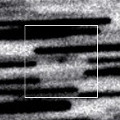
|
Now it is 16.6 mag (Apr. 1, Taras Prystavski). It is expected to brighten up to 15 mag in summer, and will be observable in excellent condition.
Date(TT) R.A. (2000) Decl. Delta r Elong. m1 Best Time(A, h)
May 9 22 10.08 -8 18.4 1.667 1.733 76 15.6 3:26 (299, 23)
May 16 22 25.97 -6 46.0 1.612 1.730 78 15.5 3:17 (298, 24)
|

|
Now it is 14.7 mag (Apr. 1, Taras Prystavski). It is observable at 15-16 mag in good condition in 2015.
Date(TT) R.A. (2000) Decl. Delta r Elong. m1 Best Time(A, h)
May 9 18 48.82 -19 53.4 7.071 7.712 126 15.6 3:26 (355, 35)
May 16 18 45.14 -20 16.7 7.006 7.742 133 15.6 3:13 ( 0, 35)
|
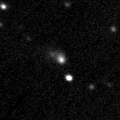
|
Now it is 14.8 mag and visible visually (Mar. 18, Sandor Szabo). It will pass close to the earth from spring to summer in 2016, and it is expected to be observable at 6-7 mag in good condition. It is already unobservable in the Southern Hemisphere. In the Northern Hemispehre, it will be getting lower gradually and will be unobservable temporarily in mid May.
Date(TT) R.A. (2000) Decl. Delta r Elong. m1 Best Time(A, h)
May 9 4 53.74 33 21.1 5.340 4.494 29 15.7 20:27 (123, 11)
May 16 4 56.72 33 22.3 5.328 4.426 24 15.6 20:35 (127, 6)
|
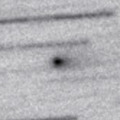
|
Now it is 16.0 mag recently (Apr. 17, A. Maury, J.-F. Soulier, T. Noel, J.-G. Bosch). In this apparition, it turns to approach to the sun down to 1.17 a.u., and it was expected to brighten up to 13 mag from March to May. But actually, it brightened up to 15.5 mag at best.
Date(TT) R.A. (2000) Decl. Delta r Elong. m1 Best Time(A, h)
May 9 20 35.39 -11 54.9 0.480 1.188 99 15.7 3:26 (322, 35)
May 16 20 55.04 -10 26.5 0.488 1.206 101 15.8 3:17 (321, 36)
|
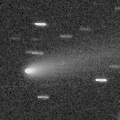
|
It brightened up to 13 mag in winter. Now it is fading, 15.2 mag (Apr. 12, Sandor Szabo). It keeps observable in good condition for a while.
Date(TT) R.A. (2000) Decl. Delta r Elong. m1 Best Time(A, h)
May 9 11 15.41 16 9.3 2.068 2.658 115 15.7 20:27 ( 14, 71)
May 16 11 18.43 15 9.1 2.182 2.695 109 15.9 20:35 ( 33, 67)
|
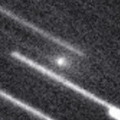
|
Now it is 14.7 mag (Apr. 8, C. W. Hergenrother). It approaches to the earth, and brightens up to 15-16 mag from April to May. But it will be fainter than 18 mag in late July. It is observable in excellent condition in the Southern Hemisphere. It will be observable in excellent condition after May also in the Northern Hemisphere.
Date(TT) R.A. (2000) Decl. Delta r Elong. m1 Best Time(A, h)
May 9 21 28.94 -12 44.3 0.734 1.220 87 15.7 3:26 (310, 26)
May 16 21 42.21 -5 37.3 0.738 1.239 88 15.8 3:17 (306, 33)
|

|
Now it is 17.6 mag (Apr. 17, A. Diepvens), fainter than predicted. It will brighten up to 13 mag in 2016. It will be getting lower after this, and will be unobservable in early June.
Date(TT) R.A. (2000) Decl. Delta r Elong. m1 Best Time(A, h)
May 9 6 52.50 25 57.2 3.209 2.740 53 16.0 20:27 (102, 30)
May 16 7 3.30 25 37.4 3.258 2.715 49 16.0 20:35 (105, 25)
|
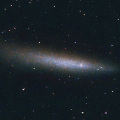
|
The spacecraft observed it brightened rapidly from 9 mag up to 2 mag when passing near by the sun. The nucleus has been already disintegrated, but the remnant was visible bright also on the earth (Mar. 7, Juan Jose Gonzalez). Now it is fainter than 10.3 mag (Mar. 17, Marek Biely). It locates high in the evening sky in the Northern Hemisphere. It is not observable in the Southern Hemisphere.
Date(TT) R.A. (2000) Decl. Delta r Elong. m1 Best Time(A, h)
May 9 5 49.83 53 31.2 2.499 1.985 48 16.0 20:27 (137, 30)
May 16 6 9.38 53 28.9 2.671 2.103 46 16.4 20:35 (138, 28)
|
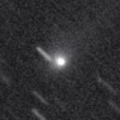
|
Now it is 14.8 mag (Mar. 21, Taras Prystavski). In the Northern Hemisphere, it keeps 15-16 mag and observable in excellent condition until early summer. It locates somewhat low in the Southern Hemisphere.
Date(TT) R.A. (2000) Decl. Delta r Elong. m1 Best Time(A, h)
May 9 12 44.93 29 30.5 3.341 3.980 122 16.1 21:37 ( 0, 84)
May 16 12 42.54 28 14.3 3.435 4.010 118 16.2 21:07 ( 0, 83)
|
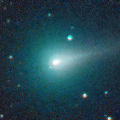
|
It brightened up to 10.6 mag from autumn to winter (Nov. 29, Seiichi Yoshida). Now it is fading. It has already faded down to 14.3 mag (Mar. 24, Taras Prystavski). It keeps observable for a long time until the comet fades out.
Date(TT) R.A. (2000) Decl. Delta r Elong. m1 Best Time(A, h)
May 9 17 29.28 -14 52.2 1.793 2.680 144 16.2 2:25 ( 0, 40)
May 16 17 23.30 -15 0.2 1.816 2.753 152 16.4 1:52 ( 0, 40)
|

|
It brightened up to 13 mag in 2014. It will be fading slowly after this. It is observable at 16 mag in excellent condition from summer to winter in 2015.
Date(TT) R.A. (2000) Decl. Delta r Elong. m1 Best Time(A, h)
May 9 0 37.42 -2 58.0 4.298 3.596 40 16.2 3:26 (271, -3)
May 16 0 44.86 -2 12.9 4.246 3.611 45 16.2 3:17 (273, 0)
|

|
It has not been observed yet in this apparition. But it must have already brightened up to 16.5 mag. It will be observable at 13 mag in good condition from summer to autumn.
Date(TT) R.A. (2000) Decl. Delta r Elong. m1 Best Time(A, h)
May 9 22 31.27 -13 3.3 1.958 1.927 73 16.5 3:26 (299, 16)
May 16 22 47.24 -11 50.0 1.870 1.898 75 16.2 3:17 (298, 17)
|
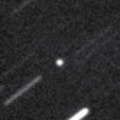
|
Now it is 16.7 mag (Apr. 19, J. Gonzalez). It keeps observable after this while the comet will be getting brighter graudually. It will brighten up to 11 mag from autumn to winter. But it locates low at that time.
Date(TT) R.A. (2000) Decl. Delta r Elong. m1 Best Time(A, h)
May 9 14 23.24 7 27.8 1.341 2.290 153 16.7 23:15 ( 0, 62)
May 16 14 16.10 7 47.9 1.325 2.246 147 16.8 22:40 ( 0, 63)
|

|
Now it is 18.3 mag (Apr. 19, Mt. Lemmon Survey). It will brighten rapidly, and will be observable at 16.5 mag in good condition from May to July.
Date(TT) R.A. (2000) Decl. Delta r Elong. m1 Best Time(A, h)
May 9 16 32.72 -18 27.6 0.874 1.850 158 16.9 1:28 ( 0, 36)
May 16 16 31.66 -16 52.3 0.836 1.831 164 16.7 1:00 ( 0, 38)
|
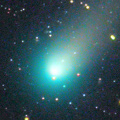
|
It brightened rapidly in outburst in mid October in 2013, then it keeps bright as 8-10 mag for a long time until 2014 summer. Now it is fading. It has already faded down to 15.8 mag (Feb. 9, Taras Prystavski). In the Southern Hemisphere, it keeps observable in good condition for a long time after this until the comet fades out. It is not observable in the Northern Hemisphere.
Date(TT) R.A. (2000) Decl. Delta r Elong. m1 Best Time(A, h)
May 9 1 6.39 -31 48.8 5.704 5.211 56 16.7 3:26 (293,-24)
May 16 1 12.44 -31 54.4 5.697 5.272 60 16.8 3:17 (294,-22)
|
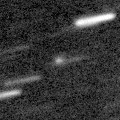
|
Now it is 17.7 mag (Feb. 17, K. Hills). It keeps observable at 17 mag from spring to summer. It locates somewhat low in the Northern Hemisphere.
Date(TT) R.A. (2000) Decl. Delta r Elong. m1 Best Time(A, h)
May 9 17 16.07 -28 25.6 2.267 3.163 147 16.8 2:12 ( 0, 27)
May 16 17 12.66 -28 8.5 2.225 3.168 154 16.7 1:41 ( 0, 27)
|
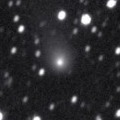
|
Getting observable again in the morning sky. It is fading, but it is observable at 17 mag in good condition until late autumn.
Date(TT) R.A. (2000) Decl. Delta r Elong. m1 Best Time(A, h)
May 9 23 44.50 13 13.8 6.213 5.583 47 16.8 3:26 (265, 17)
May 16 23 46.25 13 10.9 6.168 5.627 53 16.8 3:17 (268, 20)
|

|
First return of a periodic comet discovered in 1994. Now it is 17.5 mag (Mar. 23, iTelescope Observatory, Siding Spring). It will brighten up to 15 mag from summer to autumn, and will be observable in excellent condition in the Southern Hemisphere. It locates somewhat low in the Northern Hemisphere.
Date(TT) R.A. (2000) Decl. Delta r Elong. m1 Best Time(A, h)
May 9 21 59.41 -32 14.1 2.717 2.856 87 17.0 3:26 (318, 7)
May 16 22 9.37 -32 7.3 2.607 2.826 91 16.8 3:17 (319, 8)
|
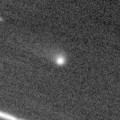
|
Now it is 16.3 mag (Apr. 19, Catalina Sky Survey). It keeps 17 mag for a long time from 2014 to 2016.
Date(TT) R.A. (2000) Decl. Delta r Elong. m1 Best Time(A, h)
May 9 10 59.89 -18 8.9 4.793 5.405 122 16.9 20:27 ( 10, 36)
May 16 10 54.31 -17 25.4 4.905 5.413 115 17.0 20:35 ( 22, 35)
|
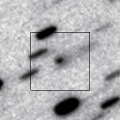
|
Now it is 17.2 mag (Mar. 24, iTelescope Observatory, Siding Spring). It keeps 17 mag until July. It is observable in excellent condition in the Southern Hemisphere. It locates somewhat low in the Northern Hemisphere.
Date(TT) R.A. (2000) Decl. Delta r Elong. m1 Best Time(A, h)
May 9 16 40.20 -23 52.7 1.604 2.559 155 17.1 1:36 ( 0, 31)
May 16 16 35.69 -23 54.3 1.578 2.564 163 17.1 1:04 ( 0, 31)
|

|
Now it is 17.5 mag (Apr. 27, Hidetaka Sato). It will be observable at 15 mag in good condition in autumn.
Date(TT) R.A. (2000) Decl. Delta r Elong. m1 Best Time(A, h)
May 9 23 35.05 -1 46.7 2.827 2.383 54 17.2 3:26 (280, 10)
May 16 23 47.27 -0 38.7 2.738 2.360 57 17.1 3:17 (280, 12)
|
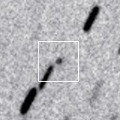
|
Now it is 17.5 mag (Apr. 21, T. H. Bressi, R. A. Mastaler). It keeps 17 mag until summer.
Date(TT) R.A. (2000) Decl. Delta r Elong. m1 Best Time(A, h)
May 9 21 9.61 13 6.1 1.804 1.978 84 17.2 3:26 (291, 48)
May 16 20 53.35 16 51.3 1.675 1.996 92 17.1 3:17 (295, 57)
|

|
First return of a periodic comet discovered in 2008. Now it is 19 mag (Apr. 5, WISE). It will approach to the earth from spring to summer, and brighten rapidly. It will brighten up to 16 mag, and will be observable in good condition.
Date(TT) R.A. (2000) Decl. Delta r Elong. m1 Best Time(A, h)
May 9 21 2.17 -7 15.2 0.899 1.375 91 17.5 3:26 (312, 35)
May 16 21 31.11 -6 46.3 0.842 1.335 91 17.2 3:17 (310, 34)
|
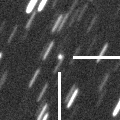
|
Brightened rapidly, and it kept brightening even after the perihelion passage. It brightened up to 15.8 mag and visible visually in March (Mar. 18, Sandor Szabo). But it will be fading after this. Now it is 16.8 mag (Apr. 17, T. Linder, R. Holmes). It is observable in excellent condition in the Northern Hemisphere. It is not observable in the Southern Hemisphere.
Date(TT) R.A. (2000) Decl. Delta r Elong. m1 Best Time(A, h)
May 9 8 50.06 44 34.0 2.230 2.215 76 17.2 20:27 (119, 58)
May 16 9 6.62 42 50.9 2.329 2.256 73 17.4 20:35 (116, 54)
|
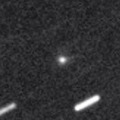
|
Now it is 17.4 mag (Apr. 15, Catalina Sky Survey). It will brighten up to 14 mag and will be observable in good condition in 2016.
Date(TT) R.A. (2000) Decl. Delta r Elong. m1 Best Time(A, h)
May 9 12 32.87 3 21.6 2.814 3.627 137 17.2 21:25 ( 0, 58)
May 16 12 30.68 3 32.9 2.851 3.593 130 17.2 20:55 ( 0, 58)
|
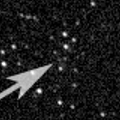
|
It brightened rapidly, and brightened up to 15.7 mag (Jan. 31, Hidetaka Sato). But it is fading now.
Date(TT) R.A. (2000) Decl. Delta r Elong. m1 Best Time(A, h)
May 9 16 17.63 -34 38.4 0.922 1.888 155 17.3 1:14 ( 0, 20)
May 16 16 12.54 -35 21.9 0.950 1.934 160 17.7 0:41 ( 0, 20)
|
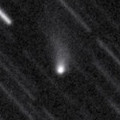
|
It brightened up to 15.3 mag in winter (Jan. 17, Taras Prystavski). Now it is fading. It is observable in good condition in the Southern Hemisphere. It will be observable in good condition after June also in the Northern Hemisphere.
Date(TT) R.A. (2000) Decl. Delta r Elong. m1 Best Time(A, h)
May 9 0 58.42 -22 54.4 2.680 2.175 50 17.3 3:26 (286,-18)
May 16 0 57.72 -21 42.8 2.628 2.209 54 17.3 3:17 (287,-14)
|
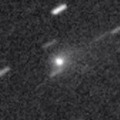
|
It Brightened up to 15.2 mag and visible visually in March (Mar. 18, Sandor Szabo). Now it is fading. It has already faded down to 17.0 mag (Apr. 18, E. Bryssinck). It keeps observable in good condition for a while.
Date(TT) R.A. (2000) Decl. Delta r Elong. m1 Best Time(A, h)
May 9 11 47.56 10 54.8 1.827 2.538 124 17.3 20:40 ( 0, 66)
May 16 11 49.55 10 23.3 1.928 2.569 118 17.5 20:35 ( 12, 65)
|
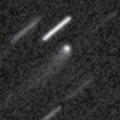
|
Now it is 17.4 mag (Apr. 14, A. Klotz, F. Kugel, J. Nicolas, C. Rinner). It keeps observable at 17-18 mag for a long time from 2013 to 2016. It keeps locating high in the Northern Hemisphere. It keeps locating very low in the Southern Hemipshere.
Date(TT) R.A. (2000) Decl. Delta r Elong. m1 Best Time(A, h)
May 9 16 8.05 65 16.6 6.510 6.702 96 17.3 1:04 (180, 60)
May 16 15 53.26 65 41.7 6.546 6.714 95 17.3 0:22 (180, 59)
|

|
Now it is 17.9 mag (Mar. 21, W. Hasubick). It was observed at 17 mag in 2014 summer. In the Northern Hemisphere, it is observable at 17.5 mag in excellent condition also in 2015. It is not observable in the Southern Hemisphere.
Date(TT) R.A. (2000) Decl. Delta r Elong. m1 Best Time(A, h)
May 9 21 53.25 46 57.7 4.399 4.142 68 17.4 3:26 (236, 51)
May 16 21 59.65 48 2.2 4.382 4.165 71 17.4 3:17 (235, 53)
|
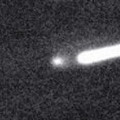
|
It brightened up to 15.5 mag from autumn to winter (Nov. 25, Taras Prystavski). Now it is fading. It has already faded down to 17.5 mag (Apr. 15, A. Diepvens). It keeps observable in good condition for a while.
Date(TT) R.A. (2000) Decl. Delta r Elong. m1 Best Time(A, h)
May 9 17 56.23 -8 12.0 1.643 2.475 136 17.5 2:52 ( 0, 47)
May 16 17 52.80 -8 7.1 1.632 2.518 143 17.6 2:21 ( 0, 47)
|

|
First return of a new periodic comet which brightened up to 12 mag in 2009. It seems to brighten up to 17 mag in summer. It is observable in good condition in the Southern Hemisphere. In the Northern Hemisphere, it keeps locating extremely low after June.
Date(TT) R.A. (2000) Decl. Delta r Elong. m1 Best Time(A, h)
May 9 9 18.52 -6 58.2 1.356 1.774 96 17.9 20:27 ( 44, 37)
May 16 9 28.04 -6 35.7 1.375 1.733 91 17.8 20:35 ( 51, 34)
|

|
Now it is 17.6 mag (Sept. 14, Mitsunori Tsumura). It has brightened in outburst up to 14 mag twice, in 2006 January and 2011 May. It passes the perihelion in 2015. It keeps observable at 17 mag for a long time after this.
Date(TT) R.A. (2000) Decl. Delta r Elong. m1 Best Time(A, h)
May 9 23 8.49 -4 19.9 6.233 5.818 61 17.9 3:26 (286, 14)
May 16 23 12.37 -3 57.0 6.136 5.818 67 17.9 3:17 (288, 17)
|
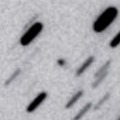
|
Now it is 17.0 mag (Apr. 1, Catalina Sky Survey). It was observed around 17-18 mag in early 2014. It will be observable around 17-18 mag again from 2014 autumn to 2015 spring, in excellent condition in the Northern Hemisphere. It is not observable in the Southern Hemisphere.
Date(TT) R.A. (2000) Decl. Delta r Elong. m1 Best Time(A, h)
May 9 9 53.84 46 40.0 5.296 5.325 86 17.9 20:27 (129, 68)
May 16 9 56.17 45 25.5 5.400 5.340 81 17.9 20:35 (122, 63)
|
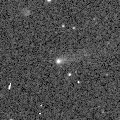
|
It had been observed at 15 mag for a long time from 2013 to 2014. Now it is fading. It will be observable at 18 mag in good condition from spring to summer. It locates somewhat low in the Northern Hemisphere.
Date(TT) R.A. (2000) Decl. Delta r Elong. m1 Best Time(A, h)
May 9 19 36.47 -29 23.7 4.599 5.130 116 17.9 3:26 (344, 24)
May 16 19 36.13 -29 36.3 4.526 5.151 123 17.9 3:17 (349, 25)
|
|
![]()
 C/2014 N3 ( NEOWISE )
C/2014 N3 ( NEOWISE ) C/2014 A4 ( SONEAR )
C/2014 A4 ( SONEAR ) C/2013 A1 ( Siding Spring )
C/2013 A1 ( Siding Spring ) C/2006 S3 ( LONEOS )
C/2006 S3 ( LONEOS ) 57P/du Toit-Neujmin-Delporte
57P/du Toit-Neujmin-Delporte C/2010 S1 ( LINEAR )
C/2010 S1 ( LINEAR ) C/2013 X1 ( PanSTARRS )
C/2013 X1 ( PanSTARRS ) 218P/LINEAR
218P/LINEAR 32P/Comas Sola
32P/Comas Sola C/2015 F2 ( Polonia )
C/2015 F2 ( Polonia ) 116P/Wild 4
116P/Wild 4 C/2015 D1 ( SOHO )
C/2015 D1 ( SOHO ) C/2013 V2 ( Borisov )
C/2013 V2 ( Borisov ) C/2014 R1 ( Borisov )
C/2014 R1 ( Borisov ) 117P/Helin-Roman-Alu 1
117P/Helin-Roman-Alu 1 51P/Harrington
51P/Harrington 10P/Tempel 2
10P/Tempel 2 221P/LINEAR
221P/LINEAR C/2012 X1 ( LINEAR )
C/2012 X1 ( LINEAR ) 299P/2014 D2 ( Catalina-PanSTARRS )
299P/2014 D2 ( Catalina-PanSTARRS ) C/2011 J2 ( LINEAR )
C/2011 J2 ( LINEAR ) 318P/2014 M6 ( McNaught-Hartley )
318P/2014 M6 ( McNaught-Hartley ) C/2013 G9 ( Tenagra )
C/2013 G9 ( Tenagra ) P/2015 F1 ( PanSTARRS )
P/2015 F1 ( PanSTARRS ) 61P/Shajn-Schaldach
61P/Shajn-Schaldach C/2015 H1 ( Bressi )
C/2015 H1 ( Bressi ) 319P/2015 G1 ( Catalina-McNaught )
319P/2015 G1 ( Catalina-McNaught ) P/2014 X1 ( Elenin )
P/2014 X1 ( Elenin ) 53P/Van Biesbroeck
53P/Van Biesbroeck C/2014 W9 ( PanSTARRS )
C/2014 W9 ( PanSTARRS ) C/2014 AA52 ( Catalina )
C/2014 AA52 ( Catalina ) 70P/Kojima
70P/Kojima C/2012 K8 ( Lemmon )
C/2012 K8 ( Lemmon ) C/2013 G3 ( PanSTARRS )
C/2013 G3 ( PanSTARRS ) 40P/Vaisala 1
40P/Vaisala 1 P/2009 L2 ( Yang-Gao )
P/2009 L2 ( Yang-Gao ) 174P/(60558) 2000 EC98 ( Echeclus )
174P/(60558) 2000 EC98 ( Echeclus ) C/2013 U2 ( Holvorcem )
C/2013 U2 ( Holvorcem ) P/2012 B1 ( PanSTARRS )
P/2012 B1 ( PanSTARRS )![]()



















































